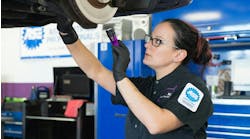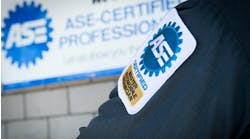VMRS charting new horizons to improve cost equipment reporting
In today's fast-paced world, there is a need for consistent communication. Too many times the lines of communication break down and things come to a grinding halt — especially when it comes to equipment maintenance. Fortunately, industry data professionals have an important tool to deal with these challenges: the Vehicle Maintenance Reporting Standard (VMRS).
Managed by ATA’s Technology & Maintenance Council (TMC), VMRS is the conduit that keeps the information moving in the right direction with precision and clarity. For more than 50 years, VMRS has reflected the many changes that have occurred in equipment maintenance — adapting as equipment, technology, and systems evolve.
VMRS is a coding convention that standardizes equipment cost reporting. It consists of data elements called Code Keys that can describe every action, part, or function of a vehicle and any maintenance or specification associated with it. In these Code Keys, TMC populates Codes to describe specific traits of a part, vehicle, labor task, warranty, activity, etc. There are more than 64 active Code Keys, but the most commonly known deal with parts and labor.
The most commonly known Code Key deals with parts, Code Key 33, “Component Code.” It is a nine-character data element that has three portions to it: System-Assembly-Component.
The following is an example of what the code would be for a front brake lining: 013-001-015 where :
- System: 013 Brakes
- Assembly within system: 001 Front Brakes and Drums
- Part level within assembly: 015 Brake Lining, Front
There are more than 30,000 codes in VMRS and it is constantly growing.
TMC works with equipment users, fleets, original equipment manufacturers (OEMs), parts suppliers, and software firms when adding new codes to the VMRS database. That’s what keeps VMRS relevant and vital for all users. VMRS is a structured coding system that provides the discipline to operate in today’s point-and-click world.
VMRS had always included codes for new and emerging technologies. Collision avoidance system codes were introduced in 2002 with more than 35 codes listed. In 2006, TMC included codes for the lane departure and exhaust aftertreatment systems.
Many times, new codes are added prior to the release of the technology. For example, selective catalytic reduction (SCR) system codes were added in 2008, two years prior to the system being mandated by law. TMC worked with several truck OEMs to enter the codes and have them ready for general use.
Electric lane assist assembly codes were recently added to VMRS, as well as codes for a fifth-wheel electronic sensor coupling system. VMRS codes were also added to reflect the newer antifreeze compounds found in today’s equipment; there are VMRS codes for OAT, NOAT, and HOAT types of coolant.
There are codes for newer aerodynamic devices such as wheel covers and splash guards. There are also new VMRS codes for a trailer rear tail extender assembly and codes for a trailer walking floor assembly.
TMC is currently collaborating with several manufacturers on developing VMRS codes for electric vehicle components. It’s vital to have the manufacturing community’s support and assistance when entering codes for new and emerging technologies because adding new VMRS codes is truly a collaborative effort. As new technologies are introduced, TMC will continue to make sure that VMRS contains the codes needed for implementation and general use by all concerned.
There is more to VMRS than the nine-digit Component Code. There are also Code Keys for describing asset types, labor functions, and part failures, among others. A new Code Key was recently added for recording tire position using four data points; axle type, axle sequence, left/right position, and inner/outer/center orientation. Another new Code Key has been requested as a proposed means to designate the frequency/time of a maintenance occurrence. Both new Code Key requests came from key industry stakeholders who feel that implementing VMRS is an important part of their business model.
An important aspect of VMRS is its ability to provide data for measuring the performance and reliability of specific components used for benchmarking studies. In 2018, TMC partnered with Fleetnet America, headquartered in Cherryville, North Carolina, to provide a unique TMC fleet member benefit. TMC fleet members receive a quarterly roadside breakdown benchmarking report that is based on VMRS System codes. Participants in the study have access to a digital dashboard that provides real-time data allowing them to compare their breakdown data with other participating fleets.
There have been a multitude of changes in the trucking/transportation industry in the past 50 years, and VMRS has been there as an important part of equipment maintenance. Fleet managers have always relied on VMRS to provide them with the best method for producing maintenance reports, so it’s imperative that VMRS contains codes for the latest technologies.
“For MOTOR Information Systems, the VMRS Codes are important in our ongoing effort to standardize parts, labor, and service information across all types of vehicles from passenger car to tractor trailers and beyond,” said Paul Moszak, TMC’s VMRS Codes Committee Chairman.
Equipment maintenance has seen a lot of changes over the years, but VMRS is still the tried and true method of tracking maintenance repairs. VMRS will continue to chart new horizons as equipment maintenance continues to evolve. VMRS will be there for future generations as it has for the past 50 years.
Jack Poster, TMC’s VMRS Services Manager, has worked in the transportation industry for more than 30 years. His family owned a Chrysler-Plymouth agency in Western Pennsylvania. After college, Jack returned to help run the dealership. Later, he worked for Merchant’s Tire & Auto. After 19 years with Merchant’s, he took a position with Mancon Inc. and became familiar with VMRS. In 2007, he left Mancon to become TMC’s VMRS Services Manager.


